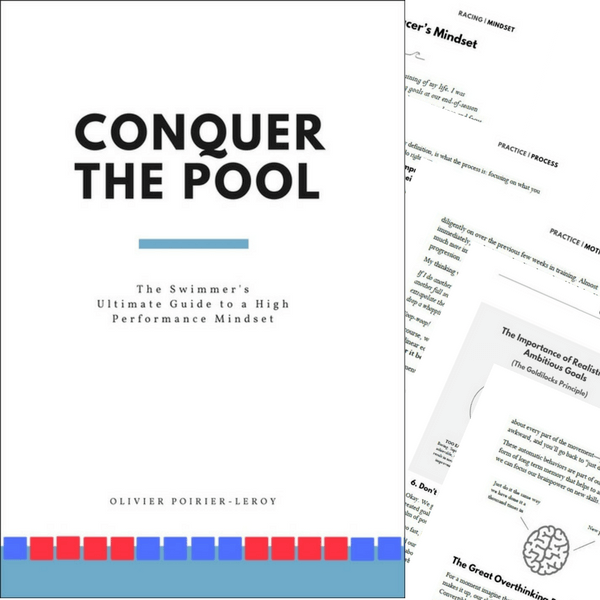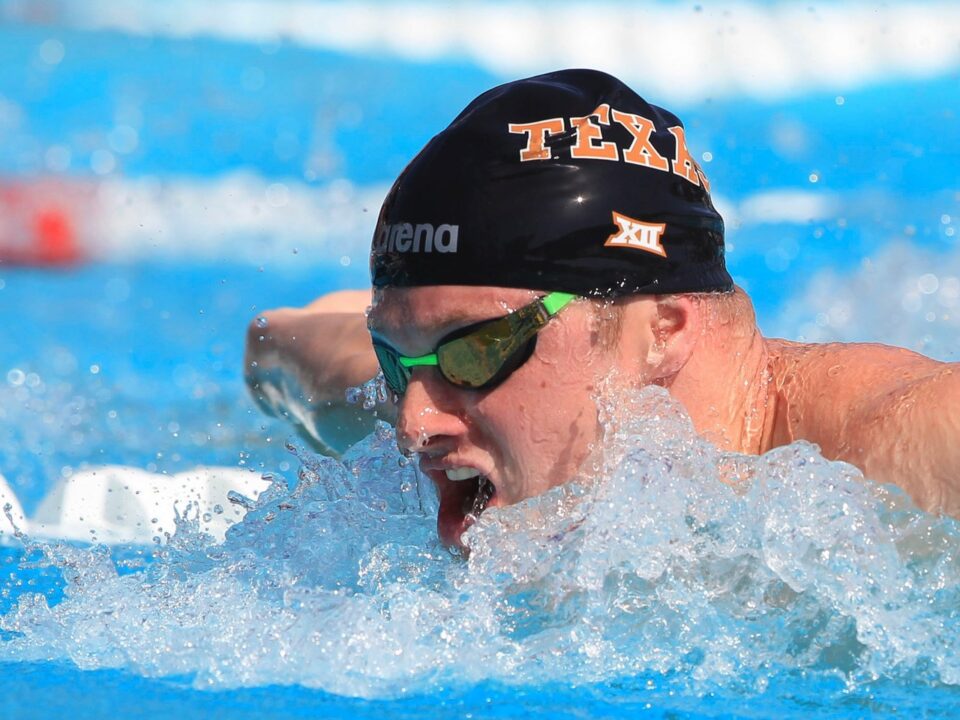Get swim meet-ready: Here are eight tips for tapering like a champion.
Swimming has its quirks, from mastering technique, to doing the right type of dryland, to picking out the right tech suit for competition.
But nowhere does second-guessing hit swimmers and swim coaches harder than when it comes to tapering.
How long should the taper last? When should it start? How hard should swimmers go?
In this set of tips for a perfect swim taper, we will look at the key principles for a successful taper so that you can swim fast when it matters most.
Whether it’s your first Big Meet or the biggest swim meet of your career, don’t blow all of your hard work by wrecking your taper.
Let’s dive in.
Tips for a Perfect Swim Taper
While tapering can often feel difficult to perfect—and don’t worry, even the best swim coaches on the pool deck struggle to get it right from time to time—there are some key principles to tapering for swimmers you can follow.
They include:
- Keep the intensity but reduce the volume.
- Use a slow decay taper.
- Focus on race performance.
- Get more sleep.
- The more muscle you have, the more rest you will need.
- Test your taper.
- Avoid last-minute additions.
- Learn from each taper.
Next, we will examine each tip in more detail, including the science behind a successful taper and advice from some of the best swim coaches on the planet for how they manage tapers for their swimmers.
1. Keep the intensity but reduce the volume.
Tapering can be achieved by reducing volume, frequency and/or intensity.
However, with reduced overall training comes the risk of detraining.
A way to avoid this is by reducing overall volume while maintaining intensity in training (i.e., race pace training) to maintain and even improve swim-specific adaptations leading into competition.
Per one study on tapers published in the Scandinavian Journal of Medicine & Science in Sports, high-intensity efforts during a taper encourage maximal “performance adaptations in both moderately trained subjects and highly trained athletes.”
In other words, keep swimming fast but reduce overall volume.
Bob Bowman, the longtime coach of Michael Phelps and head coach of the 2016 US Olympic men’s swim team, advises only turning down one or the other when tapering.
“The key thing for me is to not drop the volume and the intensity; that’s a recipe for failure,” said Bowman.
2. Peak in week one and use a slow decay design.
When tapering, taper.
That means gradually reducing work instead of showing up on day one of the taper and dropping intensity and volume by 95%.
A study with 32 elite swimmers found that swim meet performance was best when swimmers used a “slow decay” design with the swim taper, including a training load peak during the first week.
Another study published in the International Journal of Sports Medicine found that a slow and progressive reduction in training load was more effective than a sudden reduction for improving performance.
Slow and steady with tapering is the best approach to swimming fast and furious on race day.
3. Focus on race performance in training.
Tapering isn’t just about getting rest; it’s a time for sharpening the swim you want to deliver at the swim meet.
Whether that’s hitting front-end speed or hitting race pace targets, doing flip turns at race pace (hint: dive from the side of the pool 10m out to acclimatize yourself to doing turns at speed), or doing broken swims, tapering is when you transition to “competition” mode.
Tapering is a time to sharpen the details, both in terms of swim performance and mindset.
Ways you can do this:
- Broken swims to hit race pace.
- Sets for front-end speed to taste faster-than-race-pace speeds.
- Use the same warm-up that you will use in the competition.
- Practicing finishes and turns at race speed.
- Relay takeovers with your teammates.
- Visualizing your race day performance before and/or after swim practice.
And so on.
Tapering is a time to get your racing swim cap on, so get into that racing mindset!
4. Get more sleep.
Tapering is frequently a time where swimmers catch up on sleep.
Whether that’s because your coach schedules the morning workouts to start a little later, or because of reduced training frequency, the taper period is an excellent opportunity to get more sleep.
The performance benefits of sleep extension are almost unbelievable. A study with members of the Stanford University swim team found that when swimmers got more sleep—10 hours per night—swim performance improved significantly.
Time to 15m improved by a whopping 0.51 seconds. Reaction time off the blocks improved by 0.15 seconds. Turn speed also improved by 0.10 seconds.
Getting more sleep will not only maximize your swim taper but it’s also simply the most enjoyable way to get faster in the pool.
5. The more muscle you have, the more rest you need.
Sprinters and more muscley-bound swimmers require more time to recover during the taper.
“If they don’t have muscle, they don’t taper much,” says Eddie Reese, 6-time Olympic coach for Team USA and longtime coach for the Texas Longhorns men’s swim team.
It’s common to see distance swimmers barely drop any volume heading into the final week before the competition, while bulkier sprint swimmers may require up to 4-6 weeks of taper to maximize recovery and power in the water.
6. Test your taper by racing after the Big Meet.
If we swim a best time in competition and exceeded our expectations, it’s safe to say the taper worked. Nailed it!
But what if it didn’t? How can we determine if swimmers have rested too much or too little?
Swimmers and coaches can create a personalized taper plan by having swimmers participate in time trials a few days after a major competition to assess their level of rest.
Reese, for instance, employed this approach with his Texas swimmers to gauge the effectiveness of their tapers.
After big meets, he instructed them to race from the starting blocks to evaluate whether they were excessively or insufficiently rested.
This kind of intel is crucial in understanding how tapers affect you.
7. Avoid the urge to “add” something.
Taper time means extra rest, which means extra energy.
This can lead swimmers to do a last-minute add-on to their training routine, whether an extra heavy lift in the gym or “just one more” high-volume and high-intensity swim workout.
Keeping the proverbial horse in the barn at this stage of preparation can be difficult for swimmers (and swim coaches) accustomed to feeling run down and tired throughout the season and who suddenly feel amazing.
“I know for a fact that if you think about adding something within a three-week taper that will help them, you are wrong,” says Reese. “Leave it alone and it will help them more. There is nothing more you can do.”
Tapering for peak performance requires controlled and focused effort and ignoring that urge to spontaneously add something at the last minute.
8. Learn from each taper.
Learn what works for you. Each swimmer is a bit different.
Some swimmers respond better with more volume leading up to a meet. Other swimmers respond better with more rest compared to the average swimmer.
Ultimately, the best way to learn is to go through the process a few times and assess what works best to get you in a state for peak performance.
“Experience is your best teacher of what works,” said Australian coach Michael Bohl in an interview with Inside with Brett Hawke.
What happens during a swim taper?
During a swim taper, swimmers undergo several important physiological and psychological changes in preparation for a swim meet.
- Faster swimming. A swim taper aims to cut workload, triggering a super-compensation effect that results in faster swim times. Research on competitive swimmers indicates a roughly 3% performance enhancement through tapering.
- Increased power. With the increased rest of a swim taper, swimmers generate more power in the water. A group of collegiate swimmers were tested on a swim tether before and during their end-of-season taper phase and found that power increased by 5% during the taper.
- Improved mood. Tapering not only boosts swim performance but also enhances mood and reduces tension. A study involving 27 competitive swimmers during taper revealed significant mood improvements, including reduced tension and depression.
How long should swimmers taper?
Generally, swimmers taper between 7-21 days. Factors influencing taper duration include training load before the taper, stroke specialty, and muscle mass.
A study published in the Journal of Medicine Science and Sports Exercise found that peak arm power was at its highest during the first and third weeks for a group of elite male collegiate swimmers. This study was done with Eddie Reese and his swimmers at Texas.
A meta-analysis of 27 studies that assessed the performance of competitive athletes after tapering found that a training volume decrease of 41-60% solicited the best results. The most effective duration for the taper was two weeks.
As mentioned earlier, many factors go into executing a perfect swim taper, including muscle mass, training history, and swim meet events.
Wrapping It Up
Ultimately, the best way to learn how to master the swim taper is to build up the reps of having gone through the process.
And if you feel yourself feeling frustrated, you will find that you are in excellent company:
“Taper is an art that no one understands,” says Reese, the winningest NCAA coach in history. “Sometimes you just have to make your best guess.”
Happy tapering!
ABOUT OLIVIER POIRIER-LEROY
Olivier Poirier-Leroy is a former national-level swimmer. He’s the publisher of YourSwimBook, a ten-month logbook for competitive swimmers.
 He’s also the author of the recently published mental training workbook for competitive swimmers, Conquer the Pool: The Swimmer’s Ultimate Guide to a High-Performance Mindset.
He’s also the author of the recently published mental training workbook for competitive swimmers, Conquer the Pool: The Swimmer’s Ultimate Guide to a High-Performance Mindset.
It combines sport psychology research, worksheets, anecdotes, and examples of Olympians past and present to give swimmers everything they need to conquer the mental side of the sport.
Ready to take your mindset to the next level?
Click here to learn more about Conquer the Pool.

When do you suggest hitting a 40-60% drop in training volume, considering you also have to do a slow decrease in volume. Does the 40-60% decrease usually come 2 days before a meet or over a week before?
Conger being the picture is kind of ironic considering he wasn’t the best taper swimmer (outside of 2017 NCs)